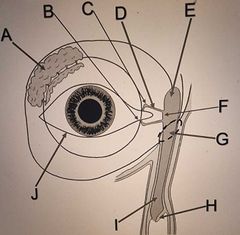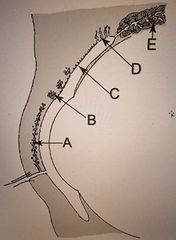![]()
![]()
![]()
Use LEFT and RIGHT arrow keys to navigate between flashcards;
Use UP and DOWN arrow keys to flip the card;
H to show hint;
A reads text to speech;
5 Cards in this Set
- Front
- Back

Label the Lacrimal System |
A: Lacrimal Gland B: Puncta C: Ampulla D: Canaliculus E: Fundus of Lacrimal Sac F: Sinus of Maier G: Lacrimal Foramen H: Valve of Hasner I: Nasolacrimal Duct J: Lid Margin |
|

Label the Accessory Glands |
A: Tarsal Gland B: Glands of Wolfring C: Goblet Cells D: Glands of Krause E: Lacrimal Gland |
|
|
What does the Lacrimal Gland produce exactly? |
Serous fluid Some mucous Lysozyme, Ɓ-lysine and Lactoferrin which are bactericides All for the tears film |
|
|
State the 3 layers of the tear film, their size and what they are produced by |
Superficial layer: Oily (Lipid) phase 0.2 - 0.9um Produced by tarsal/meibomian glands Middle layer: Aqueous (Watery) phase 90% of total thickness Produced by lacrimal and accessory glands Inner layer: Mucous phase 0.5um Produced by Goblet Cells |
|
|
What are the functions of the three layers of the tear film? |
Oily: Prevents lids sticking and reduces overflow and evaporation of tears Aqueous: Hydration, metabolic exchange, remove foreign bodies, anti-bacterial proteins Mucous: Wetting agents and allows Watery layer to adhere to cornea |

